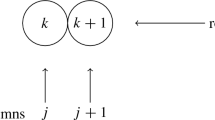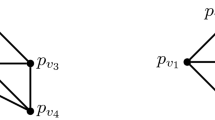Abstract
The rigidity of a matrix A for target rank r is the minimum number of entries of A that must be changed to ensure that the rank of the altered matrix is at most r. Since its introduction by Valiant (1977), rigidity and similar rank-robustness functions of matrices have found numerous applications in circuit complexity, communication complexity, and learning complexity. Almost all n × n matrices over an infinite field have a rigidity of (n − r)2. It is a long-standing open question to construct infinite families of explicit matrices even with superlinear rigidity when r = Ω(n).
In this paper, we construct an infinite family of complex matrices with the largest possible, i.e., (n − r)2, rigidity. The entries of an n × n matrix in this family are distinct primitive roots of unity of orders roughly exp(n 2 log n). To the best of our knowledge, this is the first family of concrete (but not entirely explicit) matrices having maximal rigidity and a succinct algebraic description.
Our construction is based on elimination theory of polynomial ideals. In particular, we use results on the existence of polynomials in elimination ideals with effective degree upper bounds (effective Nullstellensatz). Using elementary algebraic geometry, we prove that the dimension of the affine variety of matrices of rigidity at most k is exactly n 2 – (n – r)2 + k. Finally, we use elimination theory to examine whether the rigidity function is semicontinuous.
Similar content being viewed by others
References
Brownawell W.D. (1987) Bounds for the degrees in the Nullstellensatz. Annals of Mathematics 126(3): 577–591
W.Bruns & U.Vetter (1980). Determinantal Rings, volume 1327 of Lecture Notes in Mathematics. Springer-Verlag.
M.Cheraghchi (2005). On matrix rigidity and the complexity of linear forms. Electronic Colloquium on Computational Complexity (ECCC) (070).
Codenotti B. (2000) Matrix rigidity. Linear Algebra and its Applications 304(1–3): 181–192
D.Cox , J.Little & D.O’Shea (2007). Ideals, Varieties, and Algorithms: An Introduction to Computational Algebraic Geometry and Commutative Algebra. Undergraduate Texts in Mathematics. Springer, New York, 3rd edition.
A.Dickenstein , N.Fitchas , M.Giusti & C.Sessa (1991). The membership problem for unmixed polynomial ideals is solvable in single exponential time. Discrete Appl. Math. 33(1-3), 73–94. Applied Algebra, Algebraic Algorithms, and Error-Correcting Codes (Toulouse, 1989).
D.Eisenbud & J.Harris (2000). The Geometry of Schemes, volume 197 of Graduate Texts in Mathematics. Springer-Verlag, New York.
J.Forster (2002). A linear lower bound on the unbounded error probabilistic communication complexity. Journal of Computer and System Sciences 65(4), 612–625. Special issue of papers from Conf. on Computational Complexity (CCC), 2001 (Chicago, IL).
J.Forster , M.Krause , S.V. Lokam , R.Mubarakzjanov , N.Schmitt & H.U. Simon (2001). Relations between communication complexity, linear arrangements, and computational complexity. In FSTTCS 2001: Foundations of Software Technology and Theoretical Computer Science, volume 2245 of Lecture Notes in Comput. Sci., 171–182. Springer, Berlin.
Friedman J. (1993) A note on matrix rigidity. Combinatorica 13(2): 235–239
R.Hartshorne (1977). Algebraic Geometry. Springer-Verlag, New York. Graduate Texts in Mathematics, No. 52.
Heintz J. (1983) Definability and fast quantifier elimination in algebraically closed fields. Theoret. Comput. Sci. 24(3): 239–277
J.Heintz & C.-P. Schnorr (1980). Testing polynomials which are easy to compute (extended abstract). In Proceedings of the 12th Annual ACM Symposium on Theory of Computing, 262–272. ACM.
M.Hindry & J.H. Silverman (2000). Diophantine Geometry: An Introduction, volume 201 of Graduate Texts in Mathematics. Springer-Verlag, New York.
M.Hochster & J.A. Eagon (1971). Cohen-Macaulay rings, invariant theory, and the generic perfection of determinantal loci. American Journal of Mathematics 93, 1020–1058.
KollÁr J. (1988) Sharp effective Nullstellensatz. Journal of American Mathematical Society 1(4): 963–975
J.M. Landsberg , J.Taylor & N.K. Vishnoi (2003). The geometry of matrix rigidity. Technical Report GIT-CC-03-54, Georgia Institute of Technology, http://smartech.gatech.edu/handle/1853/6514.
S.Lang (2004). Algebra. Springer-Verlag, revised third edition.
N.Linial & A.Shraibman (2009). Learning complexity vs. communication complexity. Combinatorics, Probability & Computing 18(1-2), 227–245.
Lokam S.V. (2000) On the rigidity of Vandermonde matrices. Theoretical Computer Science 237(1-2): 477–483
Lokam S.V. (2001) Spectral methods for matrix rigidity with applications to size-depth tradeoffs and communication complexity. Journal of Computer and System Sciences 63(3): 449–473
S.V. Lokam (2006). Quadratic lower bounds on matrix rigidity. In Proceedings of International Conference on Theory and Applications of Models of Computation (TAMC 2006), volume 3959 of Lecture Notes in Computer Science.
Lokam S.V. (2009) Complexity Lower Bounds using Linear Algebra. Foundations and Trends in Theoretical Computer Science 4(1-2): 1–155
W.Narkiewicz (2004). Elementary and Analytic Theory of Algebraic Numbers, volume XI of Springer Monographs in Mathematics. Springer.
R.Paturi & P.Pudlák (2004). Circuit lower bounds and linear codes. In Notes of Mathematical Seminars of St.Petersburg Department of Steklov Institute of Mathematics, E.A. Hirsch , editor, volume 316 of Teoria slozhnosti vychislenij IX, 188–204. Technical Report appeared in ECCC : TR04-04.
A.A. Razborov (1989). On rigid matrices. Manuscript, (Russian).
I.R. Shafarevich (1994). Basic Algebraic Geometry. 1. Varieties in Projective Space. Springer Verlag, 2nd edition.
D.A. Spielman , V.Stemann & M.A. Shokrollahi (1997). A remark on matrix rigidity. Information Processing Letters 64(6), 283 – 285.
L.G. Valiant (1977). Graph-theoretic arguments in low-level complexity. In Proceedings of the 6th Symposium on Mathematical Foundations of Computer Science, volume 53 of Lecture Notes in Computer Science, 162–176. Springer Verlag.
Author information
Authors and Affiliations
Corresponding author
Rights and permissions
About this article
Cite this article
Kumar, A., Lokam, S.V., Patankar, V.M. et al. Using Elimination Theory to Construct Rigid Matrices. comput. complex. 23, 531–563 (2014). https://doi.org/10.1007/s00037-013-0061-0
Received:
Published:
Issue Date:
DOI: https://doi.org/10.1007/s00037-013-0061-0




